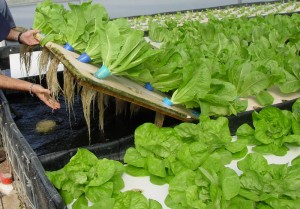There are many different configurations of aquaponic systems. The components common to every aquaponic system are the fish tank and a soil-free plant bed. The variables include filtration components, plumbing components, the type of plant bed and the amount and frequency of water circulation and aeration. Generally speaking, systems that utilize some filtration to remove the solid fish waste will have higher production of fish and plants than those that don’t use filtration.
There are three primary aquaponic methods emerging in the industry; raft, NFT and media-filled beds. Each of these methods is based on a hydroponic system design, with accommodations for fish and filtration.
Nelson and Pade, Inc.®’s Clear Flow Aquaponic Systems® utilize the original raft system designs with enhancements to increase productivity. Our ZDEP® (near Zero Discharge-Extra Production) systems incorporate a unique filtration system that nearly reduces waste and incorporates NFT and media-beds to increase and diversify vegetable production.
Raft
 In a raft system (also known as float, deep channel and deep flow) the plants are grown on polystyrene boards (rafts) that float on top of water. Most often, this is in a tank separate from the fish tank. Water flows continuously from the fish tank, through filtration components, through the raft tank where the plants are grown and then back to the fish tank.
In a raft system (also known as float, deep channel and deep flow) the plants are grown on polystyrene boards (rafts) that float on top of water. Most often, this is in a tank separate from the fish tank. Water flows continuously from the fish tank, through filtration components, through the raft tank where the plants are grown and then back to the fish tank.
The beneficial bacteria live in the raft tank and throughout the system. The extra volume of water in the raft tank provides a buffer for the fish, reducing stress and potential water quality problems. This is one of the greatest benefits of the raft system. In addition, the University of the Virgin Islands and other research programs refined this method during 25 years of research. Nelson and Pade, Inc.® utilizes the raft method as the base of their highly productive Clear Flow Aquaponic Systems®.
In a commercial system, the raft tanks can cover large areas, best utilizing the floor space in a greenhouse. Plant seedlings are transplanted on one end of the raft tank. The rafts are pushed forward on the surface of the water over time and then the mature plants are harvested at the other end of the raft. Once a raft is harvested, it can be replanted with seedlings and set into place on the opposite end. The optimizes floor space, which is especially important in a commercial greenhouse setting.
NFT
 NFT (Nutrient Film Technique) is a method in which the plants are grown in long narrow channels. A thin film of water continuously flows down each channel, providing the plant roots with water, nutrients and oxygen. As with the raft system, water flows continuously from the fish tank, through filtration components, through the NFT channels where the plants are grown and then back to the fish tank. In NFT, a separate bio filter is required, however, because there is not a large amount of water or surface for the beneficial bacteria to live. In addition, the plumbing used in a hydroponic NFT system is usually not large enough to be used in aquaponics because the organic nature of the system and “living” water will cause clogging of small pipes and tubes. NFT aquaponics shows potential but, at this time, it is used less than the other two methods discussed here.
NFT (Nutrient Film Technique) is a method in which the plants are grown in long narrow channels. A thin film of water continuously flows down each channel, providing the plant roots with water, nutrients and oxygen. As with the raft system, water flows continuously from the fish tank, through filtration components, through the NFT channels where the plants are grown and then back to the fish tank. In NFT, a separate bio filter is required, however, because there is not a large amount of water or surface for the beneficial bacteria to live. In addition, the plumbing used in a hydroponic NFT system is usually not large enough to be used in aquaponics because the organic nature of the system and “living” water will cause clogging of small pipes and tubes. NFT aquaponics shows potential but, at this time, it is used less than the other two methods discussed here.
Media-filled bed
 A media-filled bed system uses a tank or container that is filled with gravel, perlite or another media for the plant bed. This bed is periodically flooded with water from the fish tank. The water then drains back to the fish tank. All waste, including the solids, is broken down within the plant bed. Sometimes worms are added to the gravel-filled plant bed to enhance the break-down of the waste. This method uses the fewest components and no additional filtration, making it simple to operate. The production is, however, much lower than the two methods described above. The media-filled bed is often used for hobby applications where maximizing production is not a goal.
A media-filled bed system uses a tank or container that is filled with gravel, perlite or another media for the plant bed. This bed is periodically flooded with water from the fish tank. The water then drains back to the fish tank. All waste, including the solids, is broken down within the plant bed. Sometimes worms are added to the gravel-filled plant bed to enhance the break-down of the waste. This method uses the fewest components and no additional filtration, making it simple to operate. The production is, however, much lower than the two methods described above. The media-filled bed is often used for hobby applications where maximizing production is not a goal.
